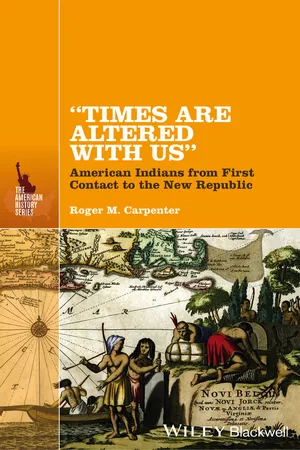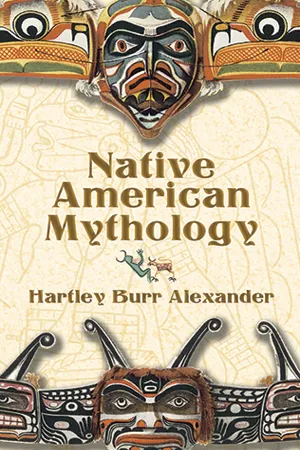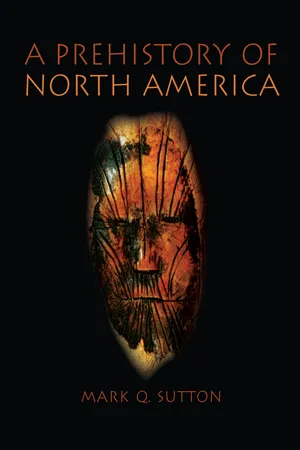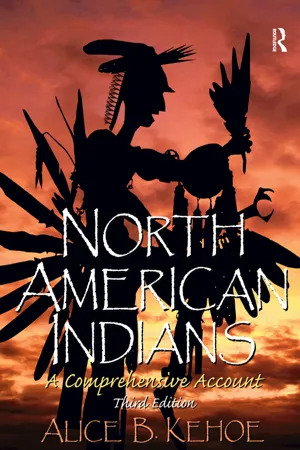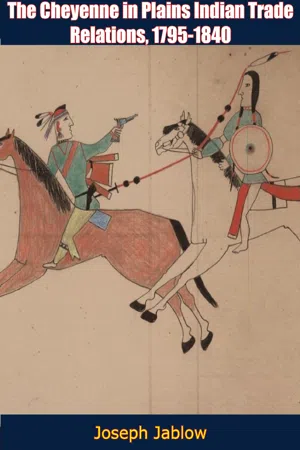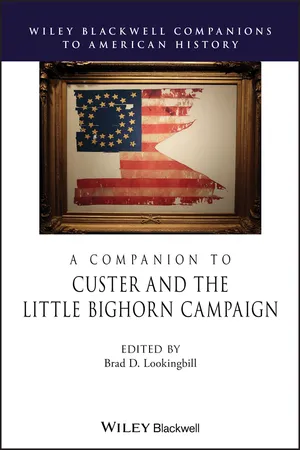History
Plains Indians
Plains Indians were a diverse group of Native American tribes who inhabited the Great Plains of North America. They were known for their nomadic lifestyle, following the migration patterns of buffalo herds for sustenance. The Plains Indians developed unique cultures, languages, and traditions, and were skilled in horseback riding and warfare.
Written by Perlego with AI-assistance
Related key terms
Related key terms
1 of 4
Related key terms
1 of 3
11 Key excerpts on "Plains Indians"
- eBook - ePub
- Britannica Educational Publishing, J.E. Luebering(Authors)
- 2010(Publication Date)
- Britannica Educational Publishing(Publisher)
Earth-lodge villages were the only settlements on the Plains until the late 16th century; they were found along major waterways that provided fertile soil for growing corn, beans, squash, sunflowers, and tobacco. The groups who built these communities divided their time between village-based crop production and hunting expeditions, which often lasted for several weeks and involved travel over a considerable area. Plains villagers include the Mandan, Hidatsa, Omaha, Pawnee, and Arikara.By 1750 horses from the Spanish colonies in present-day New Mexico had become common in the Plains and had revolutionized the hunting of bison. This new economic opportunity caused some local villagers to become dedicated nomads, as with the Crow (who retained close ties with their Hidatsa kin), and also drew agricultural tribes from surrounding areas into a nomadic lifestyle, including the Sioux, Blackfoot, Cheyenne, Comanche, Arapaho, and Kiowa.Groups throughout the region had in common several forms of material culture, including the tepee, tailored leather clothing, a variety of battle regalia (such as feathered headdresses), and large drums used in ritual contexts. The Sun Dance, a ritual that demanded a high degree of piety and self-sacrifice from its participants, was also found throughout most of the Plains.The Plains is perhaps the culture area in which tribal and band classifications were most conflated. Depictions of indigenous Americans in popular culture have often been loosely based on Plains peoples, encouraging many to view them as the “typical” American Indians.MANDAN
The Mandan were Plains Indians who traditionally lived in semipermanent villages along the Missouri River in what is now North Dakota. They spoke a Siouan language, and their oral traditions suggest that they once lived in eastern North America. According to 19th-century anthropologist Washington Matthews, the self-name Numakiki means “people.”In the 19th century the Mandan lived in dome-shaped earth lodges clustered in stockaded villages. Their economy centred on raising corn, beans, pumpkins, sunflowers, and tobacco and on hunting buffalo, fishing, and trading with nomadic Plains tribes. The Mandan also made a variety of utilitarian and decorative items, including pottery, baskets, and painted buffalo robes depicting the heroic deeds of the tribe or of individuals. At this time Mandan culture was one of the richest of the Plains. The tribe hosted many prominent European and American travelers, including American explorers Lewis and Clark, Prussian scientist Prince Maximilian of Wied-Neuwied, and artists Karl Bodmer and George Catlin. - Loretta Fowler(Author)
- 2003(Publication Date)
- Columbia University Press(Publisher)
When Europeans first entered the Plains, they encountered basically two different kinds of adaptations among the native peoples there. Riverine horticultural villages were established in the tall grass prairie along the Missouri River and its tributaries and along other rivers that flowed east into the lower Mississippi River through the Southern Plains. These autonomous villages sometimes allied. Some of the villages were fortified and all had hunting territories not too far away, where the people walked to hunt buffalo once or twice a year. Most of the year they tended their crops. These village societies were stratified to varying degrees; that is, hereditary elites held important political and religious leadership positions and were responsible for the fortunes of the village and expected to help maintain the poorer households. The other adaptation was of the nomadic buffalo hunting peoples who lived in the upland regions of the Plains in small bands. They hunted the buffalo on foot, following the herds’ seasonal moves, using dogs to transport their belongings. In the late spring to the fall, bands came together for ceremonies that helped unify and reassure the participants. Leadership was earned by achievement and personal qualities, not inherited, and social relations were egalitarian. There was room for individual innovation in religious ritual. The villagers and the nomadic peoples came into contact with one another, especially at trade centers and trade fairs where they exchanged agricultural and other products for the products of the hunt.The history of the native peoples of the Great Plains is a dynamic one in which there has been great social flux. Through trade, travel, intermarriage, and alliance there has been an exchange of peoples, ideas, and technologies. Groups split off from larger populations and combined with others. Remnants of diverse peoples, speaking a variety of languages and representing different cultural traditions , were absorbed by larger populations, and all contributed to new social orders and cultural traditions. Thus, native communities known today are modern developments. These societies all changed in response to ecological and political conditions prior to the coming of Europeans. They represent a long process of social, cultural, and linguistic reorganization.Like the native peoples, Europeans entered the Great Plains from different directions. The Spanish and French entered the Southern Plains; somewhat later, the French ventured onto the Central Plains. North of Nebraska on the Northern Plains (in the vicinity of Middle Missouri villages and the Northeastern Periphery), French traders were the first to make contact, followed by the English. Europeans relied on the help of native peoples to explore and initiate trade on the Plains. Trading relationships became essential to the colonial economies of the European nation-states and transformed the lives of native peoples in the region.- eBook - ePub
- Thomas E. Ross(Author)
- 2019(Publication Date)
- Routledge(Publisher)
As a result of these factors — disease, removal policies, warfare, early acculturation, etc., — and the general fact that the east was settled early by colonists who brought their families and came to stay, there are few large federal Indian reservations in the eastern one-third of the United States today (the largest is the Eastern Cherokee Reservation in North Carolina). However, in addition to Indians living on federal and state reservations, there are many urban Indians in the southeast and, even more so, in the northeast.The "Plains" culture area, Wissler's "Bison" food area, was located in the Great Plains region; it included some of the best known Indian tribes — the Blackfoot, Crow, "Sioux" more correctly the Dakota, and Cheyenne among others. This area provides a good example of cultural change (the famous development of the "Plains" culture after the Indians obtained horses) and its effects on Indian geography and ecology. Before ownership of horses became important and widespread in the area, there was apparently a relatively small population; most of the Indians lived along the rivers and streams of this semi-arid region, subsisting by a combination of small-game hunting, gathering, and small-scale horticulture. They lived in earthern lodges and usually engaged once a year in communal buffalo hunts, on foot.Between about 1700 and 1750, the Indians here obtained horses and a large proportion of them became full-time nomadic buffalo hunters, inventing the tipi as a portable dwelling and developing their patriarchical "Plains culture." However, some of the tribes did remain sedentary, village-dwelling farmers. Many Indians moved westward onto the plains as they got horses and learned of the "affiuency" of bison-hunting tribes in the region. Among the tribes which moved to the Great Plains from the upper Great Lakes region, apparently Minnesota, were the famous "Dakota" Indians.6The Indians of the Plains retained their lands longer than did the Eastern Indians. The region was at first considered too dry by early white settlers, and being quite distant from eastern markets was occupied much later by whites. Indian occupance in the Great Plains also endured longer because the nomadic hunters were skilled warriors and quite mobile, with their horses, rather than being "tied" to sedentary villages and fields. Eventually, their primary source of food, the bison, was hunted almost to extinction by whites; this, coupled by the technological superiority of the federal soldiers, proved too much for the Indians. White Americans had begun to settle the region in increasing numbers, needing more land (railroad companies also played a big role in the alienation of Indian lands), and the Plains Indians were forced to settle on reservations in the latter decades of the nineteenth century. - eBook - ePub
"Times Are Altered with Us"
American Indians from First Contact to the New Republic
- Roger M. Carpenter(Author)
- 2015(Publication Date)
- Wiley-Blackwell(Publisher)
At the tail end of the sixteenth century, the Spanish Crown, badgered by the Franciscans, who demanded the natives of the region be Christianized, authorized the colonization of New Mexico. Nearly a century later, the French would begin colonizing the region near the mouth of the Mississippi. In the meantime, the native people who lived between these two colonial toeholds had what could be described as second-hand encounters with Europeans. Many Native Americans in the West never laid eyes on a European, but they heard about them, and encountered their trade goods (also frequently in second-hand form) and, unfortunately, their diseases. Most important, they encountered a European import that greatly altered the way the peoples of the Great Plains would live almost until the end of the nineteenth century.No stereotype of the Native American has a stronger, more sustained hold on the popular imagination than that of the Plains Indian warrior, usually adorned in a large feathered headdress, and astride a horse. Other elements of the stereotype include large tepees and the hunting of bison from horseback. And for a while, this pervasive stereotype had a bit of truth to it. But this popular image of the Native American, propagated in numerous books and Hollywood films such as Dances with Wolves (1990), disguises the fact that this culture lasted for only about 200 years at most, beginning with the spread of horses on the Great Plains in the late seventeenth and early eighteenth centuries, and ending in the last decades of the nineteenth century, with the decimation of the bison. In a sense, the Plains horse culture was a hybrid that required Native Americans and the arrival of Europeans – and their importation of the horse – in order for it to come into existence.The Plains
Largely a windswept sea of hardy grasses whose extensive root systems enabled them to thrive in a region that saw little rainfall, the Great Plains stretch from the margins of the subarctic regions of Saskatchewan and Manitoba in the north, to the semiarid lands where Texas and the Northern Mexican Desert meet. Bordered on the west by the foothills of the Rockies and almost brushing the Mississippi River to the east, nineteenth-century American farmers would be stunned to learn just how hardy these grasses and their tramped-down root systems were, when they made their first – and usually failed – attempts to break the turf, or “bust the sod,” of the Great Plains with their plows. - eBook - ePub
- Hartley Burr Alexander(Author)
- 2012(Publication Date)
- Dover Publications(Publisher)
As in similar portions of the earth having no natural barriers to passage and intercourse, the human aboriginals of the region fell into few and vast linguistic stocks. Territorially the greatest of these was the Athapascan, which occupied all central Alaska and, in Canada, extended from the neighbourhood of the Eskimo southward through the greater part of British Columbia and Athabasca into Alberta, and which, curiously enough, also bounded the Great Plains population to the south, Athapascan tribes, such as the Navaho and Apache, occupying the plains of southern Texas, New Mexico, and northern Mexico. Just south of the northern Athapascans a stratum of the Algonquian stock, including the important Cree and Blackfoot tribes, penetrated as far west as the mountains of Alberta and Montana, while north of the southern Athapascans, as it were reciprocally, a layer of the western Shoshonean stock extended eastward into central Texas, the Shoshonean Comanche forming one of the fiercest of the Plains tribes. Between these groups, occupying the greatest and richest portion of the prairie region in the United States, were the powerful and numerous Siouan and Caddoan peoples, the former, probably immigrants from the eastern forests, having their seat in the north, while the Caddo, whose provenance seems to have been southern, were divided into three segregated groups, Texan, Nebraskan, and Dakotan. The Pawnee, Wichita, Arikara, and Caddo proper are the principal tribes of the Caddoan stock; the Siouan stock is represented by many tribes and divisions, of whom the most famous are the Dakota or Sioux, the Omaha, Assinaboin, Ponca, Winnebago, Mandan, Crow, and Osage. It is of interest to note that five states, Missouri, Kansas, Nebraska, and the two Dakotas, either bear the designations of Siouan tribes or appellations of Siouan origin, while many towns, rivers, and counties are similarly named. Other important Plains tribes, occupying the region at the base of the Rocky Mountains, from Wyoming south to northern Texas, are the Arapaho and Cheyenne of the intrusive Algonquian stock and the Kiowa, linguistically unrelated to any other people.The manner of life of the Plains tribes was everywhere much the same. They were in the main hunters, living in towns during the winter and in summer moving their portable camps from place to place within the tribal hunting range. The skin tipi, or Indian tent, was the usual type of dwelling, generally replacing the bark wigwam of the forests; but the Caddoan and some other tribes built substantial earth lodges — a form of dwelling which archaeological research shows to have been ancient and wide-spread along the banks of the great western rivers. Agriculture,24 too, was more important and more highly developed among the earth-lodge dwellers, being partly a symbol and partly a consequence of their more settled life. It found its reflection, also, in ideas, the most significant and terrible instance being that underlying the Morning Star sacrifice of the Skidi Pawnee, which, like the similar rite of the Kandhs (or Khonds) of India, consisted in the sacrifice of a virgin, commonly a captive from a hostile tribe, whose body was torn to pieces and buried in the fields for the magical fructification of the grain.29 One of the most romantic stories of the West is of the deed of Petalesharo, a Skidi warrior of renown.58 - eBook - ePub
- Mark Sutton(Author)
- 2015(Publication Date)
- Routledge(Publisher)
The western portion of the Plains is a vast, generally flat area of grassland (short grasses with shallow roots) with little surface water and few trees, often called the High Plains (it was called the “Great American Desert” by American settlers in the early 1800s). It has been estimated that some 60 million bison lived on the High Plains in 1800, plus large numbers of pronghorn antelope. This region was inhabited by mobile hunter-gatherers.The eastern part of the Plains consists of a number of widely spaced, broad valleys of the eastern-flowing rivers. This region, generally called the Prairies, is relatively well-watered and wooded and contains tall grasses with deep roots. Fewer bison lived on the Prairies, and after about 2,000 BP, it was inhabited by settled agriculturalists who also hunted bison. Some researchers have defined the Prairies as a separate culture area from the Plains, but the people of both regions shared a common tradition of bison hunting, horse utilization, and warfare (see Bamforth 1994).FIGURE 10.1 Map of the Plains showing the major subregions and the location of sites discussed in the text: 1) Bonfire Shelter; 2) Crow Creek; 3) Double Ditch; 4) Folsom; 5) Head-Smashed-In; 6) Helen Lookingbill; 7) Medicine Lodge Creek; 8) Mummy Cave; 9) Sakakawea.The climate of the Plains is quite variable, with much colder winters in the north and hotter summers in the south. Rainfall is also variable, ranging from less than eight to twenty inches a year, and it is very windy at times. There is considerable snow on the High Plains, especially in the north. Native agriculture was dependent on two critical environmental variables: at least eight inches of rain and a minimum of one hundred frost-free days. Corn could not be grown unless these two conditions were met.A BRIEF HISTORY OF RESEARCH
Although antiquities had been noted on the Plains for centuries, professional investigations began in about 1900 with work sponsored by museums and similar institutions (Wedel and Krause 2001; also see Krause 1998). Excavations were undertaken at a variety of sites all across the Plains, and a number of state historical societies and professional organizations were formed during this time. By the 1930s, several initial syntheses of Plains prehistory had been produced (e.g., Strong 1935; Wedel 1936), setting the stage for future investigations. One of the important results of the work on the Plains was the development of a method for classifying archaeological remains, called the Midwestern Taxonomic System (McKern 1939; also see Wedel 1940). This system was developed and adopted by scholars conducting research on the Plains and later over much of North America. Further, the direct connection between living native peoples and their archaeological remains on the Plains led to the development of the direct historical approach (e.g., Wedel 1938), a method widely employed throughout archaeology. - eBook - ePub
North American Indians
A Comprehensive Account
- Alice Beck Kehoe(Author)
- 2017(Publication Date)
- Routledge(Publisher)
A.D. 1600, Indians began to take horses from Spanish ranches in New Mexico. Horses made possible accumulation of more goods, from large tipis, food stores, and dress clothes to pemmican and hides to trade. In the eighteenth century, use of horses became common throughout the Plains, and a lucrative market developed to supply horses to English and French colonies in the Southeast and, in the nineteenth century, to traders and emigrants in the West. At that time, eastern nations were being displaced from their homelands and resettled on the prairie. Some prairie nations, such as Cheyenne and Sioux, gave up their agricultural villages in order to become full-time bison hunters farther west. On the High Plains, westward-moving prairie groups met eastward-expanding Numic speakers—Shoshoni and Comanche.The nineteenth century was one of great population loss from heavy warfare and from epidemics. Southeastern and then midwestern Indian nations removed to the frontier after 1830 took hunting and horse-pasture lands needed by indigenous nations and those who had moved onto the Plains a generation or two previously. By mid-century, immigration by Euro-American colonists and traders and establishment of a number of military posts put even greater pressure on the limited resources of the Plains. After 1868, transcontinental railroads made bulk transport economical, encouraging slaughtering bison for hides alone. Droughts of the 1870s were the final problem, causing failure of crops planted by many Indian nations and weakening the few remaining bison herds. After 1885, no more wild bison herds could be found. The economy of the Indian nations of the Plains was totally shattered, and all who had previously resisted relocation were forced to move to reservations, where they tried to survive on government rations that were often inadequate. Under these drastically changed conditions and with agents and missionaries avidly forbidding practice of native religions, new religions appeared in the 1890s. Foremost of these were the Ghost Dance, taught by the Nevada Paiute Wovoka (Jack Wilson), and rituals using peyote as a sacrament. Both the Ghost Dance and peyote religions taught accommodation to Euro-American patterns while affirming the value and validity of Indian experience and Indian beliefs. - eBook - ePub
- Peter Karsten, Peter Karsten(Authors)
- 2013(Publication Date)
- Routledge(Publisher)
In those cultures which have simple techniques for exploiting the habitat, warfare must of necessity be much cruder than in cultures which have complex methods of obtaining need-serving goods. In cultures with simpler techniques, long campaigns cannot be undertaken for logistic reasons. The lack of technological equipment of the primitive warrior, to say nothing of the dearth of formally organized fighting units, further distinguishes this type of struggle. Restriction in numbers of men involved in these societies generally excludes the possibility of what we would term battles. Warfare was confined primarily to small warparties, raids, forays; that is, conflicts which were brief and usually indecisive.It must be emphasized, however, that there is no evidence that primitive warfare is different in kind from that of modern states, even though the degree of difference is great. The particular forms which war may take are of course varied, but warfare everywhere and at all times is alike in one respect; it is motivated by economic need and the biological competition of societies, real or imagined, basic or otherwise. An analogy might be drawn here between a living organism and a socio-cultural system, both of which must struggle against environmental forces and against their fellow organisms.In this paper, Plains Indian tribes will be considered as those horse-using nomads whose main subsistence in the historic period was the bison. This category will include the Comanche, Kiowa, and associate Kiowa-Apache of the Southern Plains, and the Sarsi, the Blackfoot tribes, Atsina, Arapaho, Cheyenne, Crow. Teton Dakota, and Assiniboin of the Northern Plains. Marginal tribes to these are the Plains Cree and Plains Ojibwa on the north-eastern frontier, the various Shoshone groups in the mountainous regions to the west and a number of agricultural Siouan and Caddoan speaking cultures on the east and south.TRADITIONAL EXPLANATIONS OF PLAINS WARFARE Let us turn now to some of the explanations that have been advanced as the causes of Plains warfare. Linton says of this phenomenon, - Joseph Jablow(Author)
- 2020(Publication Date)
- Barakaldo Books(Publisher)
CHAPTER ONE—DYNAMIC HISTORICAL INFLUENCES ON THE PLAINS
Some Aspects of Cheyenne History
Although the Cheyenne, within a period of approximately three hundred years, experienced four modes of life involving three distinct transitions, their activities as traders encompass a relatively short time span. If they participated in the developing trade of the northeastern forest tribes of North America during the sixteenth and seventeenth centuries before their advent onto the Plains, history has failed to record that fact. Material on Cheyenne trade does not appear until after the middle of the eighteenth century, during the period of their transition to a Plains type of existence.The nature of the traditional material makes it reasonable to assume that preceding their advent into Minnesota they had a type of economy in which the hunting of small game was predominant.{5} This was followed by a semi-sedentary horticultural period of earth-lodge dwelling until at least the third quarter of the eighteenth century when they were in the process of assuming their third type of existence based on equestrian buffalo hunting and trading in the Great Plains. The latter was the heyday of the Cheyenne people during which this pattern was continued until the end of the Indian wars in the latter part of the nineteenth century. There followed immediately the fourth, the final, the inglorious phase of reservation life which was not adopted without a last burst of defiance in the name of human dignity and decency.The early history of the Cheyenne has been dealt with by Mooney,{6} Dorsey,{7} Will,{8} Clark,{9} and especially by Grinnell{10} whose various works on that group make one of the finest tributes ever accorded the American aborigine. The purpose of this chapter is, therefore, not merely to summarize generally the information provided by the foregoing authors. It attempts to re-evaluate certain historical data with regard to their effect upon the Cheyenne and to incorporate into the total picture the recently acquired archaeological information on that tribe.{11}- Brad D. Lookingbill, Brad D. Lookingbill(Authors)
- 2015(Publication Date)
- Wiley-Blackwell(Publisher)
Native American history became increasingly important, as did studying the common soldiers who fought them. Jerome Greene’s Lakota and Cheyenne: Indian Views of the Great Sioux War, 1876–1877 (1994) was similar in approach to Powell’s earlier work on the Cheyenne, seeking to use more Native sources to examine their conflict with the US Army. Elliott West’s The Contested Plains (1998) examined the broad struggle between Indians and whites for control of the Plains in the nineteenth century, setting it against the backdrop of the white settlement of Colorado and the quest for gold. Stan Hoig’s Tribal Wars of the Southern Plains (1993) discussed Native combat in stunning detail, advancing the claim that their inability to put aside tribal strife to unite and resist the whites doomed them to eventual conquest. Where Hoig’s analysis shines is in his differentiation of how whites and Natives viewed history, with Natives viewing the past as part of a larger continuum, thus giving the conflicts of the past relevance in the present. Hoig further illustrated the change over time that came to Native warfare, both from technological changes but also from differing circumstances. He noted how prior to mass European contact Natives employed a strict regimented style to their fighting, including massed infantry facing off on open fields. Furthermore, this regimentation extended to simple journeys to trade, where groups of warriors moved in battle formations in preparation for possible attack. Hoig emphasized the importance of the horse and gun in altering the nature of fighting, similar to Secoy’s earlier analysis, while also stressing the importance of the intertribal conflict of the seventeenth and eighteenth centuries as stated in McGinnis’s study of the northern Plains- eBook - ePub
The American West
The Reader
- Walter Nugent, Martin Ridge, Walter Nugent, Martin Ridge(Authors)
- 1999(Publication Date)
- Indiana University Press(Publisher)
Some of those circumstances were indirect and beyond the tribes’ ability to influence. Traders along the Santa Fe Trail shot into, chased, and disturbed the southern herds. New Mexican Ciboleros (bison hunters) continued to take fifteen to twenty-five thousand bison a year from the Llano Estacado. And the United States government’s removal of almost fifty thousand eastern Indians into Oklahoma increased the pressure on the bison herds to a level impossible to estimate. The Southern Plains tribes evidently considered it a threat and refused to abide by the Treaty of Fort Holmes (1835) when they discovered it gave the eastern tribes hunting rights on the prairies. 46 Insofar as the Southern Plains tribes had an environmental policy, then, it was to protect the bison herds from being hunted by outsiders. The Comanches could not afford to emulate their Shoshonean ancestors and limit their own population. Beset by enemies and disease, they had to try to keep their numbers high, even as their resource base diminished. For the historic Plains tribes, warfare and stock raids addressed ecological needs created by diminishing resources as well as the cultural impulse to enhance men’s status, and they must have seemed far more logical solutions than consciously reducing their own populations as the bison herds became less reliable. For those very reasons, after more than a decade of warfare among the buffalo tribes, in 1840 the Comanches and Kiowas adopted a strategy of seeking peace and an alliance with the Cheyennes, Arapahoes, and Kiowa-Apaches. From the Comanches’ point of view, it brought them allies against Texans and eastern Indians who were trespassing on the Plains. The Cheyennes and Arapahoes got what they most wanted: the chance to hunt the grass- and bison-rich Southern Plains, horses and mules for trading, and access to the Spanish settlements via Comanche lands. But the peace meant something else in ecological terms
Index pages curate the most relevant extracts from our library of academic textbooks. They’ve been created using an in-house natural language model (NLM), each adding context and meaning to key research topics.
Explore more topic indexes
Explore more topic indexes
1 of 6
Explore more topic indexes
1 of 4



